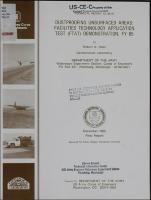Please use this identifier to cite or link to this item:
https://hdl.handle.net/11681/12649| Title: | Dustproofing unsurfaced areas : facilities technology application test (FTAT) demonstration, FY 85 |
| Authors: | Hass, Robert A. |
| Keywords: | Dust Dust control Dust palliative Dustproofing Magnesium chloride Dust prevention Modified asphalt distributor |
| Publisher: | Geotechnical Laboratory (U.S.) Engineer Research and Development Center (U.S.) |
| Series/Report no.: | Technical report (U.S. Army Engineer Waterways Experiment Station) ; GL-86-20. |
| Description: | Technical Report Abstract: Dust has been a long time enemy of the military . Dust occurs wherever military equipment operates over dry unsurfaced or gravel surfaced terrain. The amount of dust realized is directly proportional to the type and number of military vehicles operating, the duration of the particular activity, and the weather (moisture) condition during the activity. Dust occurs when small surface particles are scraped or rubbed away from the traveled surface by a vehicle tire or track and carried airborne by wind forces (in wet weather the same abraded particles are washed away in the form of mud). One vehicle crossing an open field will not usually produce an objectionable amount of dust. Objectionable large, blinding, fog-like clouds occur when many vehicles follow the same unsurfaced route. Perhaps the most familiar of these dust-producing routes is the gravel road. A good structural material for gravel roads is coarse aggregate with sufficient sand to fill the voids and adequate clay to bind these materials. Abrasion of the small clay particles begins with the passage of the first vehicle. Gradually, as more and more vehicles pass over the roadway, sufficient small particles are displaced so that the larger particles become unstable. Ruts begin to form thereby requiring maintenance to reduce the severity and extent of rutting. If sufficient clay particles are not replaced to stabilize the larger particles, the time between succeeding maintenance periods will be reduced. A good dust control material which resists the abrasion of the small particles and provides a more stable condition over a longer time period is magnesium chloride (MgCl2). This report describes demonstrations of MgCl2 application on tank trails at Fort Irwin, Calif., and on an assault airstrip at Fort Chaffee, Ark., and provides the user with instructions for the successful conduct of dust control projects. |
| Rights: | Approved for public release; distribution is unlimited. |
| URI: | http://hdl.handle.net/11681/12649 |
| Appears in Collections: | Technical Report |
Files in This Item:
| File | Description | Size | Format | |
|---|---|---|---|---|
| TR-GL-86-20.pdf | 8.36 MB | Adobe PDF |  View/Open |